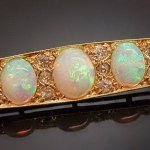We offer layaway, spread payments on the piece of your dreams. Ask us for details. Free insured shipping on all orders !!!

Antique jewelry glossary
Welcome to our extensive antique jewelry glossary with around 1,500 jewelry related entries.If you feel you are missing an explanation, feel free to let us know and we will add it.
A - B - C - D - E - F - G - H - I - J - K - L - M - N - O - P - Q - R - S - T - U - V - W - X - Y - Z all
Opal

See our: Opal jewelry.
Opal, a gemstone that is usually characterized, by a flashing mixture of prismatic colours of delicate hues when light falls upon the surface. It does not have a crystalline form but is an amorphous, gelatinous, hydrous silica containing a variable percentage (up to 20%) of water, with traces of impurities that are oxides of various metals.
There are two principal varieties of opal (with many sub-varieties):
- precious opal (or 'noble opal') that is iridescent
- common opal that has a white, milky appearance
The name 'opal' is derived from the Sanskrit word upala (gem).
When precious opal is heated, the play of colours vanishes owing to the expulsion of the water; some opals (e.g. hydrophane) show a play of colours only when dipped into water, or, more so, into oil, and lose the colour after evaporation.
A 'treated opal, developed in the 1960s, is given a dark background by soaking it in a sugar solution and then carbonizing it with sulphuric acid, or by burying it in cinders and covering it with fired oil; such treatment is difficult to detect.
The opal is usually cut en cabochon, but sometimes (especially the fire opal) is faceted, carved or engraved. The opal sometimes loses water and may crack.
The main source of the opal was Hungary (see Hungarian opal) until the stone was discovered in 1849 in Australia and later Mexico and elsewhere as to several varieties; the present greatest source is Australia, there has long been a superstition (perhaps of Teutonic origin) that wearing an opal is unlucky, sometimes attributed to the ill-fortune brought the owner of one in the novel Anne of Geierstein by sir Walter Scott; it did not deter Queen Victoria from wearing them or giving them as gifts, and it has diminished since the discovery of fine opals in Australia.
Among famous opals are:
- the Devonshire opal
- the Hungarian opal
- Prince Harlequin opal
From: An Illustrated Dictionary of Jewelry, autor: Harold Newman, publishers: Thames and Hudson









